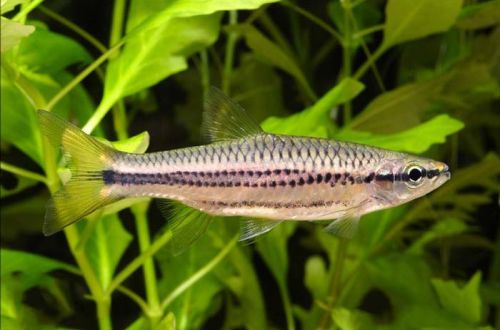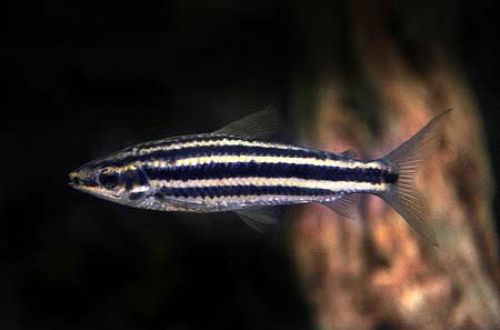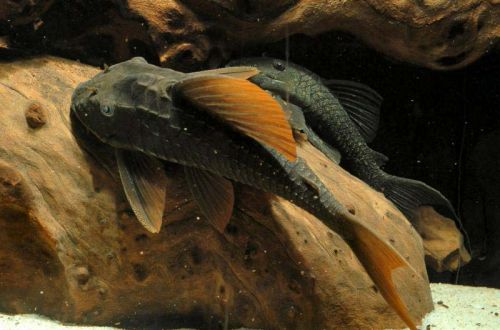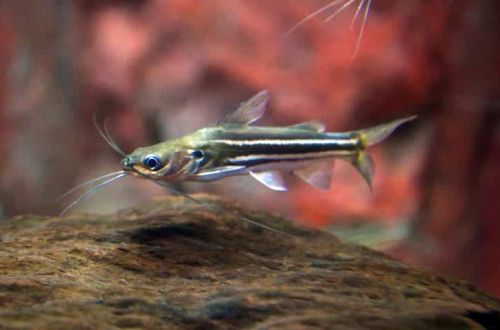
Rasbora two-lane
The two-banded rasbora, scientific name Rasbora cephalotaenia, belongs to the family Cyprinidae (Cyprinidae).
Contents
Habitat
The fish is native to Southeast Asia. It is found in the southern regions of Thailand, peninsular Malaysia and the greater Sunda Islands. Inhabits wetlands of rivers, peat bogs.
A typical biotope is a reservoir with dark brownish water with many snags, fallen leaves and other plant organic matter. Water has very low pH and dGH values.

Description
Adults reach a length of about 13 cm. The color is light gray or silver. Two dotted lines of black specks run along the body, giving the name to this species – “Two-striped”. The fins are short and translucent. The tail is relatively large.
Sexual dimorphism is weakly expressed. There are no clear visible differences between male and female.
Behavior and Compatibility
By their nature, two-lane Rasboras are a flocking species. For this reason, it is recommended to maintain a group size of 8–10 individuals. They are peaceful and get along well with other fish of comparable size and temperament, for example, with related Rasboras, Barbs, Danios, some Loaches, etc.
Brief information:
- The volume of the aquarium – from 250 liters.
- Temperature – 22-25°C
- Value pH — 5.0–7.0
- Water hardness – soft (1-12 dGH)
- Substrate type – any
- Lighting – subdued
- Brackish water – no
- Water movement – little or no
- The size of the fish is about 13 cm.
- Food – any food
- Temperament – peaceful
- Keeping in a flock of 8-10 individuals
Maintenance and care, arrangement of the aquarium
The optimal size of an aquarium for a polar cod of 8–10 individuals starts from 250 liters. In the design, it is recommended to provide places for shelters in the form of thickets of plants.
It will look most natural in an environment that resembles a natural habitat. The recommended design attributes in this case are a soft sandy substrate, several natural snags, and aquatic plants. The lighting level is subdued. To give the water a characteristic brown tint, special additives in the form of a tannin concentrate can be used and / or a layer of dried (then soaked in water) leaves of some trees can be placed on the bottom. Read more about the leaves of which trees can be used in an aquarium in a separate article.
With long-term maintenance, it is important to ensure the necessary hydrochemical composition of water and prevent excessive accumulation of organic waste. Aquarium maintenance is standard. At a minimum, it is necessary to replace part of the water with fresh water weekly and regularly remove uneaten food residues, excrement and other waste.
Food
For beginner aquarists, dry foods are the most convenient. There are usually no problems with the choice. Many manufacturers produce special products designed for Rasbor fish, containing all the necessary vitamins and minerals. Live food would be a good addition.
Breeding / breeding
Rasbora two-lane spawns in the same way as most other cyprinids. In favorable conditions, fish spawn among thickets of plants. There is no separate clutch, the eggs sink to the bottom and / or get stuck among the leaves and roots. The incubation period lasts 18–48 hours depending on the water temperature. The fry that appear begin to swim freely over the next 1–2 days.
Parental instincts are not developed, so the fish tend to eat their own eggs and offspring. With plenty of shelters, some juveniles can survive and reach maturity. However, if you plan to keep the entire brood, then breeding should be approached more thoroughly and spawning should be carried out in a separate aquarium.
Fish diseases
Fish are characterized by the same diseases as the rest of the inhabitants of the aquarium. As a rule, problems arise when kept in inappropriate conditions, hostile neighbors, poor nutrition. The external environment depresses the immune system and makes the fish susceptible to disease. Read more in the section “Diseases of aquarium fish”.





